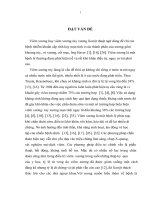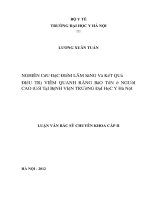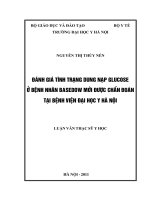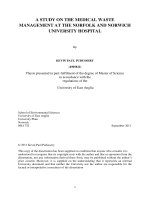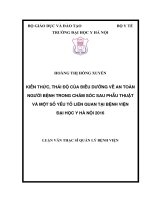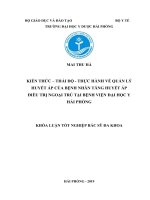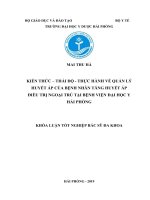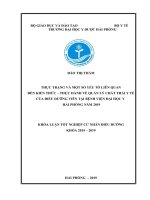nghiên cứu về quản lý chất thải y tế tại bệnh viện đại học Norwich và Norfolk Pudussery kevin 2011
Bạn đang xem bản rút gọn của tài liệu. Xem và tải ngay bản đầy đủ của tài liệu tại đây (1.23 MB, 87 trang )
1
A STUDY ON THE MEDICAL WASTE
MANAGEMENT AT THE NORFOLK AND NORWICH
UNIVERSITY HOSPITAL
by
KEVIN PAUL PUDUSSERY
(4905822)
Thesis presented in part-fulfilment of the degree of Master of Science
in accordance with the
regulations of the
University of East Anglia
School of Environmental Sciences
University of East Anglia
University Plain
Norwich
NR4 7TJ September 2011
© 2011 Kevin Paul Pudussery
This copy of the dissertation has been supplied on condition that anyone who consults it is
understood to recognise that its copyright rests with the author and that no quotation from the
dissertation, nor any information derived there from, may be published without the author‘s
prior consent. Moreover, it is supplied on the understanding that it represents an internal
University document and that neither the University nor the author are responsible for the
factual or interpretative correctness of the dissertation
2
ABSTRACT
The high generation rate of medical waste in UK is a proof that medical waste management
in UK is problematic. Based on a case study undertaken at Norfolk and Norwich University
Hospital (NNUH) this research looks in to the various issues in the field of medical waste
management. The research explores the staff‘s perception towards the medical waste
management. The study aims to examine the knowledge level and attitude and role of health
care workers towards the medical waste management. The NHS has set a 10% carbon
reduction target to be met by 2015 (NHS, 2009), as part of the strategy to meet the UK
Government‘s Climate Change Act. The study examines whether the hospital could reduce its
carbon foot print by improving the medical waste management.
The study looks in to the various medical waste treatment technologies available and choose
the best available technology for the on site treatment of medical waste. A multi criteria
decision analysis is used for the same.
The results of the study show that the health care workers have a critical role in achieving
efficient medical waste management. The study shows that hospital could highly benefit from
an on site incinerator coupled with an effective waste management programme geared to
waste minimization. This will help hospital to reduce carbon foot print and hence towards
sustainability.
3
ACKNOWLEDGEMENT
I would like to thank first and foremost Dr David Benson for his invaluable academic
supervision and enthusiasm throughout this dissertation, as well as for the support and
confidence he gave me from every meeting and point of contact that occurred from start to
finish.
I would also like to thank Dr. Matt Cashmore who is the course director and other MSc
course staff, especially Dr. Alan Bond for their advice and guidance throughout the year.
Further thanks go to Chris Paul, Graham Corke, for allowing me to conduct this study at
Norwich and Norfolk University Hospital. Thanks must also go to the people who agreed to
undertake the surveys, without which the study would have seriously have been compromised.
Finally, thanks must go to all my friends and family for their continual support and
enthusiasm towards this study, for having confidence in my ability throughout the duration of
the course.
4
ABBREVIATIONS
NNUH: Norfolk and Norwich University Hospital
UEA : University of East Anglia
WHO : World Health Organization
DoH : Department of Health
NHS: National Health Service
RCN: Royal College of Nursing
UK: United Kingdom.
DEFRA: Department of Environment food and Rural Affairs.
AoDM Association of Domestic Managers
HCW: Health care waste
EU: European Union
BAT: Best Available Technology
3Rs Reduce, Reuse and Recycle
5
TABLE OF CONTENTS
I. ABSTRACT………………………………………………………………………… ii
II. ACKNOWLEDGMENT ………………………………………………………….…iii
III. ABBREVIATION……………………………………………………………………iv
TABLE OF CONTENTS 5
LIST OF TABLES 8
LIST OF FIGURES 9
CHAPTER 1: INTRODUCTION 10
1.1) Definition and Classification of Medical Waste 10
1.2) Waste policies and legislations in UK that applies to medical waste management 11
1.3) Medical waste Management in United Kingdom (UK) and associated problems 13
1.4) Why Medical Waste Management at NNUH: Justification 13
1.5) Overall Objective and Specific Aims 14
1.6) Organisation of study 16
2.1) Medical waste management in UK 17
2.2) Best Practices for Hospital Waste Management 19
2.3) Hazardous waste transportation 20
2.4) Medical waste treatment technologies 21
CHAPTER 3: METHODOLOGY 24
3.1) Introduction to methodology 24
3.2) Interview with the Waste Management Officer at NNUH 25
3.3) Participant Observation. 27
3.4) A Questionnaire survey about the waste management practices of Staffs at NNUH
hospital 29
3.4.1) Identifying what information is needed 29
3.4.1) Deciding what sort of questionnaire to use 29
3.4.2) Framing the questions 30
3.4.3) Designing of the Self-completion Questionnaire 30
3.4.4) Creating the first draft, editing and revising 31
3.4.5) Sampling and revising 31
3.4.6) Conducting the survey 32
3.5) Questionnaire survey to understand the public perception about medical waste
treatment technologies: 32
3.5.1) Framing the questions: 32
6
3.5.2) Analysis of the result 33
3.6) Comparison of different medical waste treatment technologies 33
3.6.1) Selection of Alternative technologies. 34
3.6.2) Selection of the evaluation criteria, and analysis of possible actions. 34
3.6.3) Determination of the significant coefficients (Ranking and weighting). 35
3.6.4) Analysis of the results and selection of best technology. 36
CHAPTER 4: RESULTS 38
4.1) Primary Data Analysis 38
4.1.1) Medical waste management policy and plan at the NNUH. 38
4.1.2) Details of medical waste generated at NNUH. 39
4.1.3) GHG emissions from transportation of medical waste: 41
4.2) Health care workers perception on Medical waste and its management 43
4.2.2) Perceptions about the Constituents of medical waste: 44
4.2.3) Employees perception towards Current waste management practice 45
4.2.4) Attitude towards training 48
4.2.5) Perception towards best treatment technology 49
4.3) Consideration of alternatives:- 49
4.3.1) Capital Investment and Operational cost (C1) 49
4.3.3) Volume and Mass reduction of medical waste(C3) 51
4.3.4) Environmental Impacts of the proposed technology(C4) 51
4.3.5) Public acceptance (C5) 53
4.3.6) Training and operational requirements(C6) 54
4.3.7) Occupational Health and safety including needle stick prevention(C7) 54
4.3.8) Analysis of the result: 54
4.4) Public Perception about Medical waste treatment technologies. 56
4.4.1) Demographic data 56
4.3.2) Public perception about medical waste treatment technologies. 57
CHAPTER 5: DISCUSSION 59
5.1) Waste management policy, plans and practice 59
5.2) Practitioner‘s perception towards medical waste management. 60
5.3) Alternatives for medical waste treatment and selection of Best Available Technology.
63
5.4) Public perception about various medical waste treatment technologies. 64
5.4) Limitations of the study 64
7
6.1) Conclusion 66
6.2) Recommendations. 67
Reference 69
APPENDIX……………………………………………………………………………………………………………………………………… 67
8
LIST OF TABLES
Table 1.1: Types of medical waste ……………………………………………………….5
Table 2.1: Health care waste generation in selected countries ………………………….12
Table 3.1: Methodology of research…………………………………………………… 20
Table: 3.2: Sampling size of the surv ……………………………………………………26
Table 3.3: MCDA matrix ……………………………………………………………… 29
Table.3.4: Criteria‘s for the selection of best treatment technology ……………………30
Table 4.1: Waste segregation at NNUH……………………………………………… 32
Table 4.2: Comparison of the RCN guidance and NNUH waste management policy…. 33
Table 4.3: Calculations of GHG emissions from medical waste transportation. ……… 36
Table 4.4: demographic data of the people surveyed ……………………………………37
Table: 4.5: knowledge of employees about the constituents of medical waste …………38
Table 4.6: Ranking: Capital cost………………………………………………………… 44
Table 4.7: Ranking: On types of waste treated ………………………………………… 45
Table: 4.8: Ranking: Volume and mass reduction ……………………………………….45
Table: 4.9: Environmental impacts of various technologies…………………………… 47
Table 4.10: Ranking: Environmental impacts…………………………………………… 47
Table 4.11: Ranking: Public acceptance ………………………………………………….47
Table: 4.12: Ranking: Training and operational requirements ………………………… 48
Table: 4.13: Ranking: Occupational health and safety:…………………………………. 48
Table: 4.14: MCDA matrix ………………………………………………………………49
Table: 5.15: Demographic data of public survey ……………………………………… 50
9
LIST OF FIGURES
Figure: 1.1: The overall objective of the project…………………………………………….10
Figure: 3.1: Flow chart showing the various processes involved in an Interview ………….21
Figure: 4.1: Composition of health care waste at NNUH ………………………………….34
Figure 4.2: Employees attitude towards medical waste management for different age
groups at NNUH ………………………………………………………………………… 38
Figure: 4.3: Knowledge about the hazardous nature of medical waste ………………… 39
Figure: 4.4: Frequency of waste going to wrong bin ………………………………………40
Figure: 4.5: Problems faced by employees during segregation of medical waste………….40
Figure: 4.6: Problems faced by employees during segregation of medical waste …………………41
Figure: 4.7: Knowledge of the employees as if when the medical waste bin should be sealed … 41
Figure: 4.8: Importance of training in waste management ……………………………… 42
Figure: 4.9: Perception of workers towards various treatment Technologies …………………….43
Figure: 5.10: Figure showing the perception of people about medical waste……………… 51
Figure: 4.11: Public perception towards various medical waste treatment technologies… 52
10
CHAPTER 1: INTRODUCTION
Great strides have been made in the field of health care system over the years. Ironically,
along with restoring and maintaining community health, health care settings also threaten
their well-being. The health of public, patients and professionals alike are affected by
poor waste management practices (Shinee et al, 2008). In addition to this, it also
contributes to environmental degradation. In 1983, a meeting was held at Bergen,
Norway. The meeting was convened by the World Health Organization (WHO) regional
office for Europe. The Biomedical waste management issue was first discussed during
this meeting. The ―beach wash-ups‖ of summer 1988 bought this issue to the limelight
(Lee et al,1996). Now, years later, this has turned into a global humanitarian issue.
1.1) Definition and Classification of Medical Waste
All the wastes generated by medical activities come under Health-care waste. They are
involved in diagnostic activities and preventive, curative and palliative treatments in both
the human and veterinary fields of medicine. In short, health-care waste is all the waste
produced by a medical institution (public or private), a medical research facility or a
laboratory (Graikos et al 2010). There are two types of health care waste as shown in
table 1.1.
1) Hazardous
waste
Clinical/Infectious/medical waste, cytotoxic and cytostatic
medicines, batteries, health are chemicals and hazardous
properties, radioactive substances, X ray photo chemicals.
2) Non- Hazardous
waste.
Offensive/hygiene waste, non cyto-toxic and cyto-static
medicines, domestic waste, packaging waste, recyclable waste
food waste.
Table 1.1: Types of medical waste. (Source: The safe management of health care waste,
RCN, 2007)
11
Clinical waste is divided in to two categories:
I. Infectious waste: - It is defined under the Controlled Waste Regulations 1992 and
controlled by Section 34 of the Environmental Protection Act 1990 as (DOE
1990a):
( a)‖ Any waste which consists wholly or partly of human or animal tissue, blood or body
fluids, excretions, drugs or other pharmaceutical products, swabs or dressings or syringes,
needles or other sharp instruments, being waste which unless rendered safe may prove
hazardous (including microbial (infectious), pharmacological and /or physical [e.g.
sharps] dangers) to any person coming into contact with it‖.
(b) ―Any other waste arising from medical, nursing, dental, veterinary, pharmaceutical or
similar practice, investigation, treatment, care, teaching or research, or the collection of
blood for transfusion being waste, which may cause infection to any person coming into
contact with it‖.
II. Medicinal waste.
Medicines other than cytotoxic and cytostatic medicines come under medicinal
waste. (The safe management of health care waste, RCN; DoH, 2006)
.
1.2) Waste policies and legislations in UK that applies to medical
waste management
There are several legislative measures and policies in the UK aimed at the proper
management of health care waste. The prominent piece of legislation which governs
waste management is the EU Framework Directive (75/442/EEC) which was revised
(2008/98/EC; EU 2009). This is responsible for setting out the definitions and policies
for all other pieces of legislation (Tudor, 2009). Another crucial legislative measure in
the UK is the Environmental Protection Act (DoE, 1990) is another key legislative which
mandates that anyone involving in the management of waste should have a ‗Duty of Care‘
that ensures it effective management from cradle to grave. So, a registered waste carrier
will need to securely store and dispose of the waste to suitably licensed facility. (Moritz,
2004; Blenkharn, 2005).
12
Some health care waste fall under ―dangerous goods‖. The producers and consignors of
these are obliged under the Carriage of Dangerous Goods and Use of Transportable
Pressure Equipment Regulations for ensuring suitable categorization and identification,
packaging, marking, labeling and documentation of the waste (DfT, 2007; Tudor et al
2009).
The Health and Safety at Work Act and Control of Substances Hazardous to Human
Health COSHH) Regulations requires the health care providers to perform risk
assessments for determining and minimizing any subsequent risks to staff, patients and
the environment. New standards for incineration were also introduced by EPA. The
European Union Incineration Directive (EU 2000) caused many of these plants to close
due to the increased stringency of the emission limits to air and water. The NHS and
Community Care Act (DoH 1990) made the segregation of clinical and non clinical
waste mandatory. In addition, EPA assigned local authorities for providing collection
services for clinical waste generated through treatment at homes or other residential
settings.
The Special Waste Regulations (DoE 1996), the Hazardous Waste (England and Wales)
Regulations 2005 and the List of Waste (England) Regulations 2005, guided partly by
the EU Waste Codes caused more health care waste to be classified as hazardous and
thus creating a need for them to be appropriately consigned. Waste Incineration Directive
compliance is a criterion for new incinerators. So some categories of waste will need to
undergo alternative treatment and will have high-temperature treatment or incinerations
as its only option (Tudor 2009). Environmental permits issued either under the
requirements of the former Pollution Prevention and Control or the new Environmental
Protection Regulations give exact specifications on the amount and types of wastes that
can be treated at a facility. Under the Special Waste Regulations and the Hazardous
Waste Regulations, there should be no mixing of hazardous and non-hazardous waste
and so proper methods for segregating different streams are necessary.
13
1.3) Medical waste Management in United Kingdom (UK) and
associated problems
As a largest employer and organization in UK NHS is responsible for most of the medical
waste in UK. It employs more than 1.3 million peoplew3 and runs 259 NHS trusts. The
role of sustainability in the practices of the NHS is limited, as per the studies conducted
in the UK (Tudor 2004). In the year 2005 – 06, NHS produced 118383.22 tonnes of
clinical waste and £ 73 million was spent for the disposal. The average clinical waste per
day per patient is very high compared to other developed countries like France and
Germany (Hutchins 2009). These high generations of medical waste have been a problem
in UK for a quite long time. The quantities of healthcare waste in England and Wales
have recorded an increase of 20% between 2001- 2004. But accurate regional level
figures are limited as the number of formal systems for tracking waste quantities within
the organization is very few (woolridge et al 2005; Tudor 2005). Hence, medical waste
still continues to be a problem in the field of waste management in UK
1.4) Why Medical Waste Management at NNUH: Justification
The Norfolk Norwich University Hospital (NNUH) is a general acute hospital, which
was opened to patients in November 2000. The hospital is built by Octagon Healthcare
Limited, managed by NHS Trust staff and the nonclinical services are managed by Serco.
As a health care institution Norfolk and Norwich hospital produces a lot of medical and
surgical waste. The institutions of health care have enormous opportunity to do good or
bad to the natural environment and to increase or diminish carbon emissions (Coote,
2006). Being an environmental friendly organization, NNUH wants to decrease their
carbon foot print by improving their waste management practice. Currently, NHS is
responsible for more than 3% of all GHG emissions in England. (Cole, 2009).
Hence, there is a urgent need in NHS hospital to reduce their carbon emissions. In order
to achieve significant and long term reduction in carbon foot prints the organization
should first assess the various opportunities for carbon reduction and should develop a
structured master plan for the same (WHO, 2008).
14
The various ways to reduce the carbon foot print in hospitals are by making the right
procurement choices, introducing green travel plans, improving the waste management,
by implementing energy saving strategies (WHO, 2008; Michael 2006, Barrat et al, 2004;
Environmental health nursing, 2010). In regard to issues in waste management, higher
generation rates of medical waste due to improper segregation and waste disposal are the
key areas of concern. Waste transportation and end disposal is the area of concern in
medical waste management. Hence a study on the medical waste management is essential
to provide a structured master plan to reduce carbon emissions and hence towards
sustainability.
Health care facilities can decrease their green house gas contribution by (Environmental
Health Nursing, 2010)
Recycling and buying recycling products.
Reducing/preventing the waste generation
On site treatment of waste
The argument her is that the waste management policy should target more on waste
minimization. Also, the perception of health care staff is highly critical towards waste
minimization. This study looks on the possibility of reducing carbon emissions by
reducing the medical waste generated and also by avoiding the unnecessary transport of
medical waste by building an onsite waste treatment plant.
Since one of the objective is to consider an on-site waste treatment plant at NNUH, the
public concern their perception towards various technology cannot be neglected. Hence a
study is also done to understand the public perception towards various technologies.
1.5) Overall Objective and Specific Aims
The overall objective of this project is to perform a study on the current medical waste
management at NNUH and to aims find out how hospital can benefit from improving
medical waste management practices. The various aspects of medical waste management
discussed in this study are shown in the figure 1.1
The aims of the project are:
To analyze the current medical waste management legislations, policies and
practices at NNUH
15
To Understand the perception of staffs at NNUH towards the medical waste
management and to analyze how it affects the waste generation at NNUH
To investigate the reasons behind higher generation of medical waste at
NNUH
To find out the best suitable waste treatment technology for the on site
treatment of medical waste.
To understand the public perception towards various waste management
technologies.
Fig: 1.1: The overall objective of the project.
Medical
waste
management
Current waste
management practices
1)Waste management
legislation, policy and
practice.
2) Waste seggregation
3) Employees
perception towards
waste management
Transport ofHealth care
waste
1) Green house gas
emissions and other
problems associated with
the transport of edical
waste.
Medical waste
treatment and
disposal.
1) Medical waste
generation at NNUH
2) To find best available
technology for the
onsite treatment of
medical waste.
3) Public perception
towards various
medical waste treatment
technologies
16
1.6) Organisation of study
The dissertation is heavily concentrated on the medical waste management at NNUH.
Chapter 1 is the introduction and aims to give a basic background information‘s
regarding medical waste management and the justification for the topic. Chapter 2 looks
in to the current literature about medical waste management. The methodology used to
achieve the objectives and aims of the project is explained in chapter 3. The results of
the project are given in chapter 4 and the results are discussed in chapter 5 with
comparing it with the current literature and initial objectives. Chapter 6 concludes the
research giving some recommendations to improve the medical waste management at
NNUH.
17
CHAPTER 2: LITERATURE REVIEW
2.1) Medical waste management in UK
United Kingdom is the largest producer of health care waste in Europe. In 2007-08 hospitals
in UK produced approximately 190 000 tonnes of Health Care Waste (HCW). In addition to
that a lot of HCW is generated from the 20 000 care homes and 40 000 beauticians operating
around the country (Tudor et al, 2009). Table 1 below shows that hospitals in UK, on an
average generate 5.5 kg of medical waste per person per day, which is very high when
compared to the other developed countries.
Table 2.1: Healthcare waste generation in selected countries
Country
kg/patient/day
UK
5.5
Ireland
2.6
USA
2.2
France
1.9
Portugal
1.5
Belgium
1.4
Greece
1.4
Italy
1.0
Spain
0.6
Netherlands
0.6
Germany
0.4
Source: (krisiunas et al, 2000; Chung and Lo, 2003)
The medical waste disposal in UK has become very expensive and it is estimated that UK
spends more than £125 million for the treatment of Health Care Waste (Tudor et al, 2009).
Hence, there has been a growing interest among the various hospitals to find out different
strategies to reduce the amount of medical waste generated. Also, there has been increase in
the development of recycling programs for health care wastes in recent years. (Wen and
Eaves, 2003; Da Silva et al, 2005; NHS Estates, 2002). Although there are many literatures
available on the Medical Waste management in general, only limited studies have been done
to find out the exact reasons for higher generation and patterns of medical wastes in UK
18
(Tudor 2009). One reason might be that the waste generation pattern will be different for
different hospitals depending on the facilities and services it offer ( Ferraz et al, 2000;
Madeira 1995; ). The concept of sustainability is lacking in the health care systems in
England (Jochelson et al, 2004 Tudor, 2006). According to Tudor (2009), in UK there is a
lack of research and accurate data about the generation patterns of health care waste in order
to provide an evidence base for future decision making. The various reasons towards the poor
waste management practises around the globe are (WHO fact sheet N°253, 2007):
The absence of waste management.
Lack of awareness about the health hazards.
Insufficient financial and human resources and poor control of waste disposal.
Lack of strict and appropriate regulations.
The clear attribution of responsibility of appropriate handling and disposal of
waste.
According to the 'polluter pays' principle, this responsibility lies with the
waste producer, usually being the health-care provider, or the establishment
involved in related activities (WHO fact sheet N°253, 2007)
The technology, regulations, education and training, waste management policies in developed
countries are at an advanced stage than in developing countries. There are strict legislations at
the local, regional and national levels which are geared towards the proper management of
hazardous clinical waste generated in developing countries (WHO, 2007). The healthcare
industries in United Kingdom are generally operated under strict legislations, licenses and
code of practices, along with environment health and safety regulations (Blenkharn 2005;
WHO fact sheet N°253, 2007). The stringent environmental controls and legislation on
medical waste in UK has ensured high standards of clinical waste disposal but failed to
decrease the amount of medical waste generated in UK. (NHS Estates 2000, NHS Estates
2002; Tudor, 2005; Salkin 2003). Safe handling and storage of medical waste is still a
problem in UK despite the strict regulations. (Audit Scotland, 2005; Blenkharn 2005)Also,
most of the literature on medical waste management concentrates on the developing nations
rather than developed nation, one of the reason being poor waste management legislations
and practices in developing countries. In order to understand the reason behind higher
generation of medical waste in UK and the problems in Health Care Waste (HWM)
management at the hospitals, we need to know about the best practise for HWM in UK.
19
2.2) Best Practices for Hospital Waste Management
Major changes have been made in the management of hazardous waste so that the
requirements of the European Hazardous Waste Directive are met. In accordance with this,
there has been a revision of the guidance document Safe Disposal of Clinical Waste by NHS
Estates. On the basis of this, the department of Health revised the joint-agency guidance and
it‘s publishing its final form as a 119-page document was done on the 30th November 2006,
under the gateway reference 6874 (Department of health, 2006). As far as the best practice of
hospital waste is concerned, this document is the latest reference from the government‘s end.
Moreover, it is very details and gives information regarding all aspects of waste management.
It also gives the mandatory and optional settings. This document actually replaces the Health
Services Advisory Committee‘s guidance document ‗Safe disposal of clinical waste‘ (The
Management of Health and Safety, 1999). Revision and updating of the 1999-guidance was
done so that we can take into consideration, the changes in legislation regulating the
management of waste, its storage, transportation, treatment and disposal, and health and
safety (Tudor 2009).
On the basis of this, concise 17-page guidance on healthcare waste had been published by the
Royal College of Nursing. This guidance is widely used in UK as the best management
practice. The RCN guidance include guidelines about the definition and classification of
medical waste, waste segregation, waste assessments, waste audits, Accidents and incidents,
training and competence and community nursing. A national colour coded system is now
used for the segregation of waste and is linked to an appropriate disposal path (DoH, 2006,
RCN guidance on health care waste). Staffs are provided with different colour coded
receptacles and sack holders which should be positioned in locations close to the point of
waste production and should be replaced when ¾th full, securely tied and appropriately
labeled (DoH 2006). The argument here is that although this system helps in separating
different types of waste, it doesn‘t actually reduce the amount of waste produced. In fact it
has created some confusion among the workers to put which waste in which bin. Hence there
is every chance that the waste ends up in a wrong bin especially when the bins are kept
together. In a study conducted by Saini et al(2005), they found that there is a significant gap
of knowledge, attitude and practices among the health care employees at the hospital.
20
WHO has identified that the percentage of infectious waste in health care wastes is between
10 – 25% (Pruss, 1999). The various studies show that the amount of wastes which require
special attention is just a fraction of total health care waste generated (Blenkharn , 2005; Jang
et al, 2006; Lee et al, 2004; Ozbek and Sainin , 2004; Park and Jeong, 2001; Patil and
Shekdar, 2001; Tsakona, et al; 2007 ). These studies argue that reusing and recycling
programmes and an effective segregation of wastes can be a means of reducing rising
quantities of waste generation and disposal cost. If the waste can be reduced or recycled it
can not only reduce the disposal cost, but also return money by selling recyclable materials.
(Cheng et al, 2009; Lee et al, 2002; Lee et al, 2004). Studies by Tudor (2006) the percentage
of hazardous waste in various hospitals in UK is as high as 40 – 60%. A few researches have
shown that the percentage of non-hazardous waste disposed of in the hazardous/clinical waste
stream can often be 50–90% (Zafar & Butler 2000, AoDM 2003, Woolridge et al. 2005).
Rayner (2003) demonstrated that more than 25% of the clinical wastes can be classified as
domestic waste.
In a study conducted by Saini et al (2005), they found that by the careful segregation of items
like paper, card boards, plastics and bio degradable wastes the medical waste stream can be
reduced by 60%. The literature shows that the lack of knowledge and inefficient waste
management practices are the reasons for high generation of wastes.
2.3) Hazardous waste transportation
Unless treated using an on-site treatment technology, the clinical waste need to be transported
securely to a suitable treatment plant which has the license to treat clinical waste. The waste
transportation of hazardous waste has to comply with the strict regulations associated with it.
Due to this reason clinical waste transportation and disposal in UK is really costly (Blenkharn
2005; Tudor 2009). There is a significant amount of waste transport across UK and it is the
comparatively higher in England. It is a matter of high health and safety concerns. Also, in
addition to that it has various environmental impacts like Green House Gas (GHG) emissions.
(Tudor et al, 2005). The estimated figures for greenhouse emissions from waste transfer
station to disposal/management site is 4.3kgCO2eq/ tonne of waste.( Smith et al, 2001). The
literature shows that it is advantageous to avoid the hazardous waste wherever possible. By
21
treating the waste on-site the wastes are confined to a limited space, there by making it more
convenient and minimize the risk to public health and environment.
2.4) Medical waste treatment technologies
Literature review s on waste disposal/ waste treatment technologies are rather contradictory.
Some of the most common technologies include incinerators, sterilization or autoclave,
irradiation, sterilization, microwave, chemical disinfection and secured landfill. According to
previous studies (Park and Jeong, 2001; Lee et al., 2004), about 49–60% of medical waste is
treated by various incinerations, 20–37% by autoclave sterilization, and 4–5% by other
methods. Incineration and steam autoclave sterilization are the main methods currently being
used and are considered mature technologies. Each of the technologies mentioned above has
some advantages and some disadvantages.
Incineration utilizes thermal energy to decline waste materials to non combustible residue or
ash and exhaust gases (Dursun et al, 2011). The Fly and bottom residues produced after
medical waste incineration contain high level of heavy metal like Pb, Cd, Ni, Cr, Cu and Zn.
Medical waste aHigh values of metal leachability prohibit the land filling of these ashes as
imposed by EU directives (Gotsis 2008). Medical waste is the 3
rd
largest sources of dioxin air
emission. However, despite of public concerns about incinerators, it is the most frequently
used option, due to its advantages regarding the sterilization of pathological and anatomic
waste, volume and mass reduction, and energy recovery (Zhao et al 2008)
Autoclaving/sterilization is the second most commonly used waste disposal technology. The
process involves steaming the waste materials at lethal temperatures to penetrate and
potentially kill pathogens. (Armstrong et al 2010). Autoclave is viewed as a more costly
method than incineration (Jang et a,(2006). One of the major disadvantages of autoclave
pointed out is that it doesn‘t reduce the size of waste fed in to the system. The treated waste
then has to go to the landfill sites which again cause many environmental threats. Many
studies shows that a shredder incorporated with an autooclave can be the best option to treat
the medical waste (Armstrong et al, 2010; Brenda et al 2010)
The microwave process utilizes the radiant energy to kill infectious agents by convering
radiant energy to heat and pressure. Shredding is usually combined with microwave
22
technology. A combined on site Microwave - small scale incinerator technology is the most
cost effective and environmental friendly treatment technology. (Lee et al 2003) The
disinfection efficiency of microwave can be a performance issue for microwave (Path, 2005)
In chemical treatments, chemicals like chlorine, formaldehyde, ethylene oxide etcetera are
used as disinfectants. Again the effectiveness of disinfection is questioned as it is dependent
on the temperature, pH and surface area (Path 2005).
The above literatures show the contradictory views regarding the medical waste treatment.
One thing to be noted in these literatures is the difference in the type of waste they have
examined. The compositions of wastes they have examined vary which shows that the best
treatment should be selected depending on the characteristics of the waste. Also with the
proper reduction of waste and preventing the waste containing chlorine a mercury entering to
the incinerator can reduce the environmental impacts of medical waste incinerators. While
none of the alternative technologies are totally risk free, they can be combined with an
effective program of waste reduction and segregation to reduce the environmental impacts
and financial cost of medical waste disposal.
The criteria‘s used to evaluate technological option should consider environmental, health
and economic factors (Batterman 2004). The best technology for the medical waste treatment
will be different for different hospitals. It may depend on the local conditions and the
requirement of the hospital. However WHO gives a list of factors to guide the selection of
best technology for treating medical waste (Pruss 1999). They are: -
Disinfection efficiency
Volume and mass reduction.
Quantity of wastes for treatment.
Infrastructure requirements.
Options available for final disposal.
Operation and maintanence consideration.
Location and surroundings of the treatment site and disposal facility.
Public acceptability
Available space.
Investment and operating cost.
Health and environmental considerations.
23
Types of waste for treatment and disposal.
Regulatory requirement.
Occupational health and safety considerations.
Training requirements.
Hence, it can be interpreted from the literature that, medical waste management is an area
of high concern due to the high generation of medical waste, improper segregation and
also due contradictory views about the various technologies. Medical waste management
is an area which needs more research and study to gear iit towards sustainability.
24
CHAPTER 3: METHODOLOGY
3.1) Introduction to methodology
The methods chosen specifically relate to the aims and objectives of the research study It is
shown in table 3.1. Here, qualitative interview and participant observation data was combined
with quantitative survey material to test the arguments that .
Objectives
Methods
Out put
To collect primary data‘s
and understand the current
waste management policies
and practices at NNUH
Interview with waste
manager.
Site visits/
Participant
observation
Current waste
management policy
The waste generation
data.
Information about
medical waste
disposal.
To understand the
perception of staff towards
medical waste management
Participant
Observation
Quantitative survey
Follow up Questions
Employees interest
towards medical
waste management.
Level of
comfortableness
towards current
segregation practice.
Difficulties faced by
workers towards
current segregation
system.
Attitude towards
training and
improving waste
management.
Employees
perception towards
various treatment
Technologies
To choose the best available
technology for waste
treatment
Linear additive
model Multi criteria
decision analysis.
Selection of
technology
To understand the public
perception towards medical
waste management
Questionnaire survey
Peoples knowledge
and views towards
various treatment
technologies.
Table: 3.1: Methodology for the research.
25
I. The waste management policies should target more on waste minimization.
II. The health care workers perspective towards medical waste management is
critical towards efficient segregation and waste minimization.
Also a multi criteria decision analysis is used to find out the best treatment technology. A
quantitative public survey is also used to find out the perception of public towards the waste
treatment technologies
The methodology is explained in detail in the following sections.
3.2) Interview with the Waste Management Officer at NNUH
The purpose of the interview with the waste management officer at NNUH was to collect the
primary data and background information about the waste management practices at the
hospital. The data‘s and information‘s collected formed the basis for this research. An
interview protocol was initially developed to cover qualitative data collection that included
interview technique, sampling, ethical issues and data analysis.
Semi-structured interview - This approach is meant to assure that the some general areas of
information are collected from each interviewee; this provides more focus than the
conversational approach, but still allows a degree of freedom and adaptability in getting the
information from the interviewee.
The interviews were scheduled and conducted at a time appropriate for the interviewee
(medical waste manager at NNUH) and the interviews were undertaken in the interviewee‘s
office. Interviewer developed a rapport with interviewee as it is important in collecting
accurate and true data‘s. It was done through an initial set of questions to put the respondent
at ease. The issue of confidentiality was addressed as good interviewing techniques often
elicit personal data (Payne, 1999).
Bryman (2008) lists some of the basic elements which should be considered while preparing
interview questions. They are:
Create a certain amount of order on the topic areas, so that your questions
about them flow reasonably well, but be prepared to alter the order of
questions during the actual interview.

